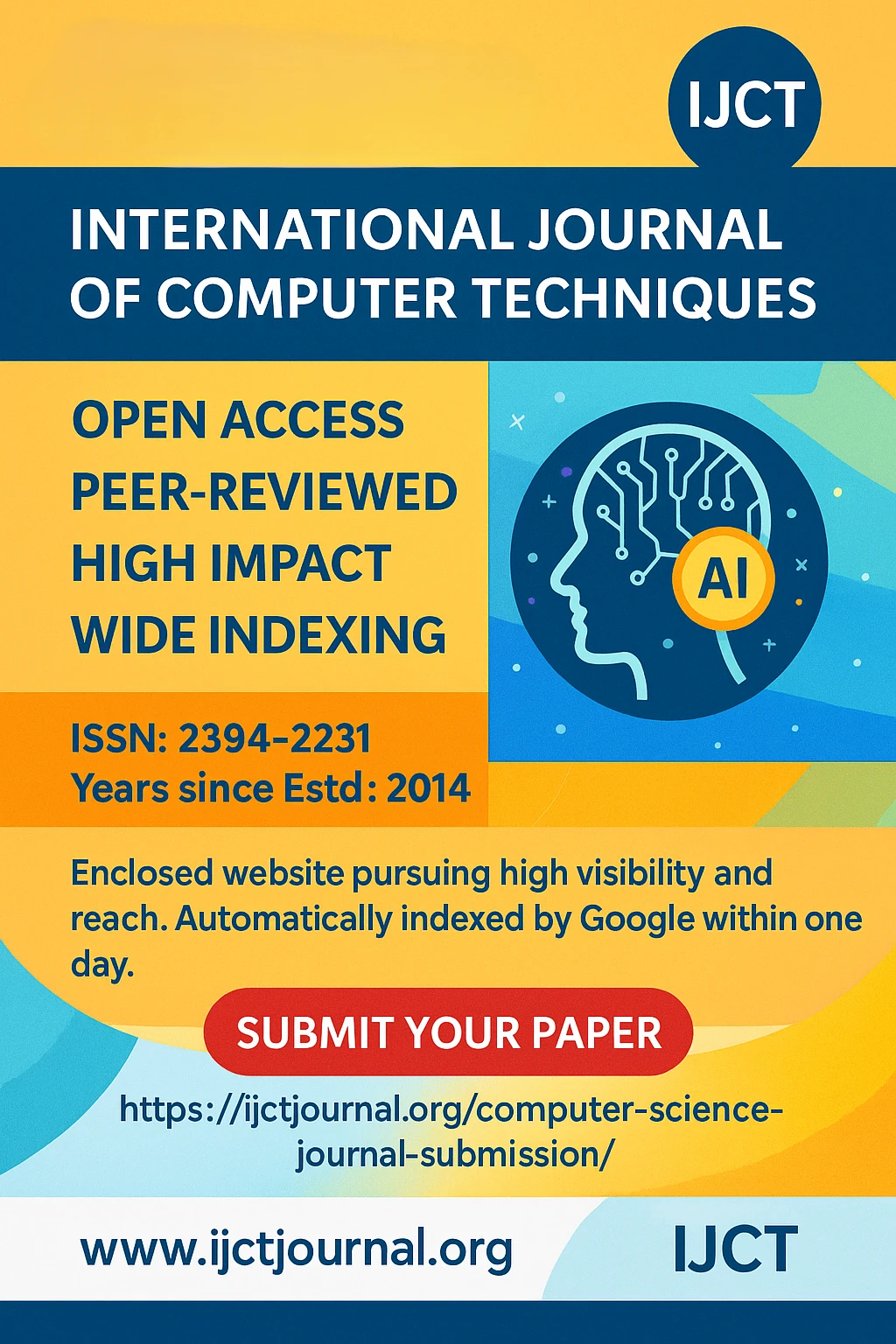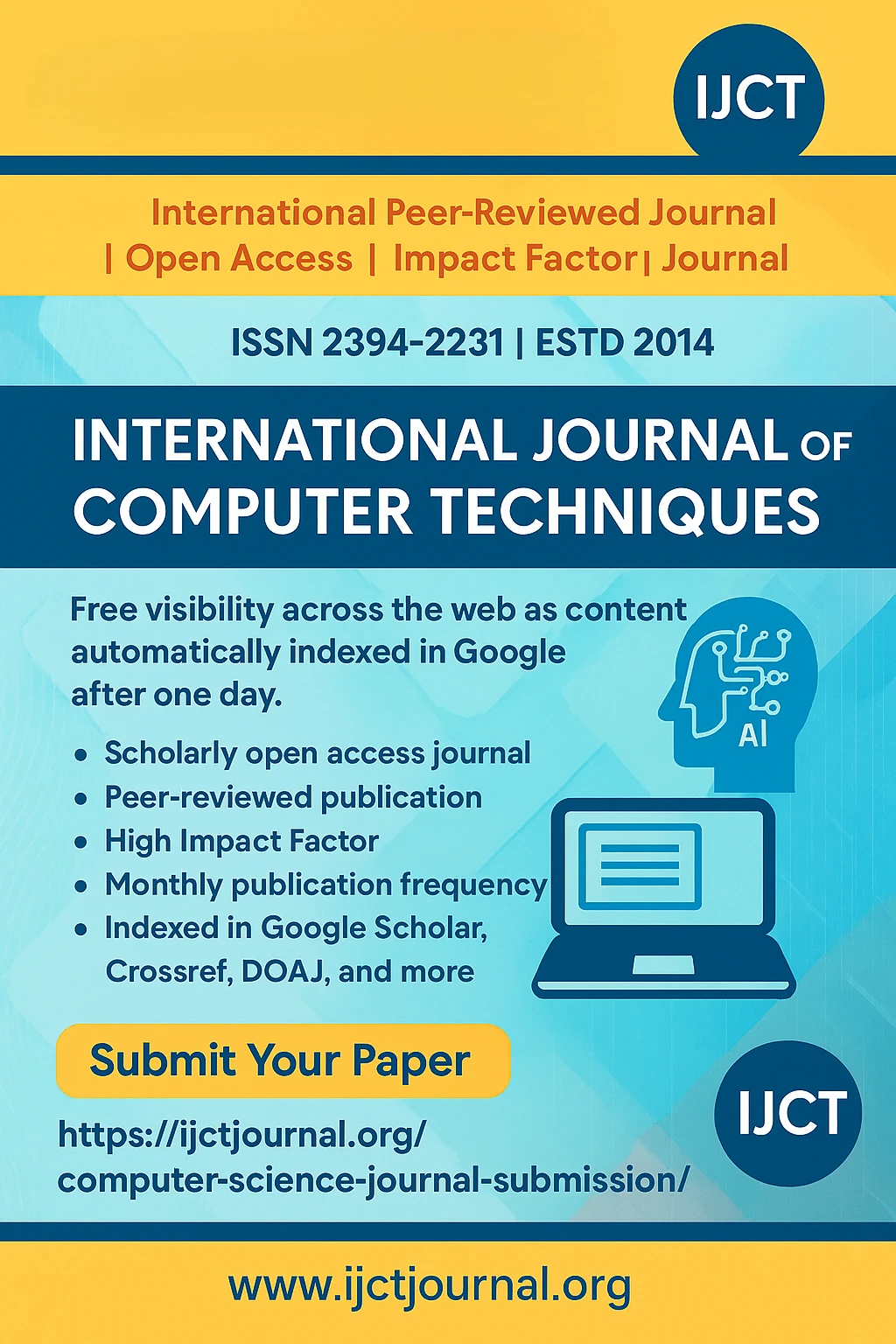
End-to-End Development of a Secure Banking Web Application with AI Investment Chatbot | IJCT Volume 12 – Issue 5 | IJCT-V12I5P58

International Journal of Computer Techniques
ISSN 2394-2231
Volume 12, Issue 5 | Published: September – October 2025
Author
Dr. K. Sundara Velrani , Henry Sam Moses D , Mahesh C , Sendouramoorthy J
Table of Contents
ToggleAbstract
This paper introduces a secure, end-to-end digital banking platform integrated with an AI-powered investment chatbot. The proposed system combines advanced frontend and backend frameworks with robust security mechanisms and intel- ligent advisory features. The architecture emphasizes scalability, usability, and data protection through modular design and AI- driven interaction. Comprehensive testing validates the system’s reliability, efficiency, and user-centric performance. Additionally, this work discusses the implementation methodology, architec- tural design, AI integration process, and performance analysis, along with potential extensions toward mobile platforms and blockchain-enabled authentication. Overall, the proposed model establishes a framework for intelligent, interactive, and secure financial services in modern FinTech environments.
Keywords
secure banking, AI chatbot, React.js, Spring Boot, Flask, JWT authentication, financial advisory, cybersecu- rity, fintech, machine learningConclusion
The comprehensive evaluation of the proposed intelligent digital banking system has demonstrated its capability to deliver reliable, secure, and efficient financial services through the effective integration of artificial intelligence and mod- ern web technologies. Extensive testing confirmed that the platform maintains high transaction reliability, rapid response times, and strong data protection mechanisms, which are critical factors in today’s digital financial environment. The AI-driven advisory module achieved notable accuracy in gen- erating relevant and personalized investment suggestions, il- lustrating the potential of artificial intelligence in optimizing user-specific financial decisions. Moreover, user assessments confirmed that the platform offers a highly intuitive and responsive interface, capable of consolidating multiple banking operations under a single system. This not only enhances usability and convenience but also contributes significantly to the overall digital transformation of banking processes.
The results of this work validate that the proposed frame- work successfully bridges the gap between traditional banking services and emerging FinTech innovations. By integrating intelligent automation, predictive analytics, and secure transac- tion handling, the system delivers a seamless and user-focused experience. The modular design further ensures flexibility, allowing additional services and data sources to be integrated with minimal effort. Such adaptability is crucial for financial institutions seeking to evolve rapidly in response to technolog- ical advancements and changing customer expectations. The AI advisory feature, in particular, demonstrates the system’s potential in delivering data-driven insights, enabling users to make informed investment and financial management deci- sions with confidence.
Despite these achievements, several limitations were ob- served that provide direction for further development. The cur- rent implementation operates primarily in a single language, restricting accessibility for users across different linguistic regions. Additionally, the use of static investment datasets limits the real-time accuracy of recommendations. Another constraint is the absence of a live payment gateway, which currently restricts the system to simulated transactions rather than active financial operations. Addressing these aspects would considerably enhance the platform’s functionality and real-world applicability.
Future work should focus on overcoming these challenges by incorporating multilingual interfaces, real-time data stream- ing, and integration with active financial networks. The in- clusion of blockchain-based verification mechanisms could significantly improve transaction transparency, security, and traceability, aligning the system with modern FinTech com- pliance standards. Developing a dedicated mobile applica- tion would also extend accessibility and encourage adoption among a broader user base. Furthermore, integrating deep learning models for behavioral analysis and fraud detection could strengthen the system’s capability to ensure secure and adaptive banking experiences.
In conclusion, this research illustrates that intelligent, se- cure, and user-centric digital banking systems can be effec- tively realized through the synergy of AI, web technologies, and modern security frameworks. The proposed model suc- cessfully enhances operational efficiency, user engagement, and trustworthiness—key pillars for the sustainability of digital financial ecosystems. By addressing current limitations and adopting future enhancements, the system can evolve into a fully dynamic, real-time, and scalable banking platform. Ul- timately, this study establishes a foundational step toward the next generation of smart financial technologies that promote automation, inclusivity, and innovation in the global FinTech domain. The proposed solution not only demonstrates the technical feasibility of AI-assisted banking but also provides a reference model for future researchers and developers seeking to advance secure, adaptive, and intelligent digital finance solutions.
References
[1]Author, J.K., “On the Integration of AI in Financial Platforms,” IEEE Transactions on Computers, vol. 10, no. 8, pp. 123–135, 2020.
[2]Chen, H., “Cybersecurity in Online Banking,” IEEE Security & Privacy, 2021.
[3]Gupta, R., “Blockchain in Digital Banking,” IEEE Access, 2021.
[4]Gupta, S.L., “Machine Learning in Banking Applications,” Journal of FinTech, 2021. [5]Johnson, M., “Financial Advisory Systems Using AI,” Springer, 2019.
[6]Khan, M.R., “Role-Based Access Control in Web Systems,” Springer, 2019.
[7]Kumar, A.R., and Singh, P., “AI-Powered Chatbots for Secure Banking,” in Proceedings of the IEEE International Conference, Paris, 2021.
[8]Kumar, D., “Intelligent Virtual Assistants in FinTech,” Elsevier, 2021.
[9]Li, C., “Hybrid AI Chatbots for Finance,” ACM Transactions on Internet Technology, 2020.
[10]Li, F., “Predictive Models for Investment Recommendation,” Springer, 2020.
[11]Mehta, A., “Deep Learning for Investment Analysis,” Springer, 2019.
[12]Nguyen, T., “AI Models for Fraud Detection,” IEEE Transactions on Information Forensics and Security, vol. 16, pp. 2345–2356, 2021.
[13]Park, J., “Advanced Fraud Detection Using ML,” Elsevier, 2020.
[14]Patel, C.D., Modern Web Security Frameworks. Springer, 2019.
[15]Patel, S.R., “Secure Financial Web Applications,” IEEE Transactions on Dependable and Secure Computing, 2020.
[16]Sharma, R., “Secure Web Application Design for Banks,” IEEE Access, vol. 8, 2020.
[17]Singh, K., “Web Security in FinTech Applications,” IEEE Software, 2021.
[18]Smith, J., “JWT Authentication in Web Applications,” IEEE Software, 2019.
[19]Wong, L., “Chatbots in Digital Banking,” Journal of AI Research, 2020.
[20]Zhang, P., et al., “Chatbots for Financial Advisory,” ACM Computing Surveys, 2020.
Journal Covers
IJCT Important Links
© 2025 International Journal of Computer Techniques (IJCT).











